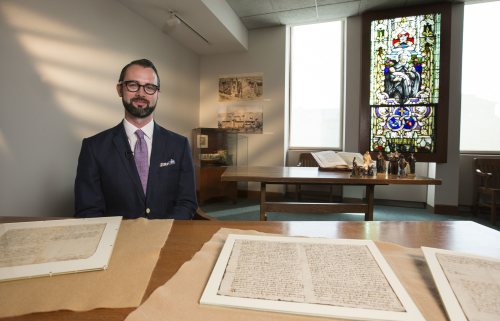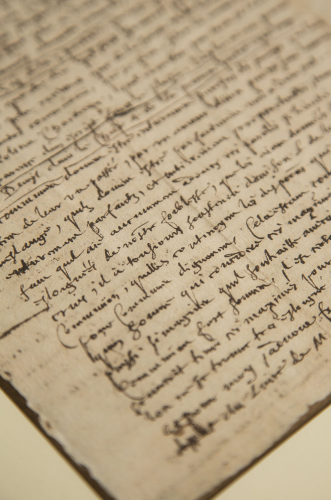Sep 19, 2014
St. Vincent de Paul’s 17th century handwritten letters go digital
St. Vincent de Paul’s 17th century handwritten letters go digital
CHICAGO — Vincent de Paul — a 17th century Catholic priest who later was canonized — wrote hundreds of letters in his lifetime, but many of the original documents remain hidden in archives and private collections. Now, scholars throughout the world can access images of eight Vincentian letters from the DePaul University archives in an online digital collection.
“Having the documents online will allow scholars to pore over the way the letters have been written: underlining, scratch-outs, and bolder passages, which cannot be replicated in the print volumes of Vincent’s correspondence,” said Andrew Rea, a DePaul librarian who oversees the Vincentian Collection.
Many of Vincent’s other letters, which are held in private collections or archives outside of the United States, are not digitized, said historian Rev. Edward R. Udovic, C.M., university secretary. Vincent is known for devoting his life to service and caring for others. He founded the Congregation of the Mission, a religious community whose members, Vincentians, established DePaul University in 1898 to serve the children of immigrants.
For decades, the university has been building its collection with the goal of becoming the premier international site for Vincentian historical research, according to Udovic. The rise of online auctions and search engines has made it easier to find manuscripts that are up for sale, he said.
“Once it’s here in our Vincentian Studies Collection, it’s here forever,” Udovic noted.
The library’s newest online collection, St. Vincent’s Handwritten Letters, offers high-resolution images, transcriptions of the original French, and translations into English. The collection also includes a digital map that shows where the letters arrived throughout Europe. An interactive timeline places the letters between 1641 and 1660, a period that was the height of Vincent’s influence in France.
“Vincent was a 17th century person, and even though his ideals and values transcend history, understanding that he was a real person and came from this specific place and time is very important,” said Udovic.
The longest and most important letter in the DePaul collection, according to Udovic, was a gift from book collector and alumnus Abel Berland in 1988. In the letter Vincent denounces the heresy of Jansenism, which emphasized human depravity and limited Catholics’ access to communion.
“For pastoral reasons, Vincent thought Jansenism undercut and distanced people from God,” said Udovic, adding that this impassioned missive shows Vincent translating theology into real life and real practice, an example of his pastoral theology.
Scholars are able to recreate a lost age and discover hidden information by reading and studying the letters. “Seventeenth century France was living through the Little Ice Age,” said Udovic. “Vincent’s comments about small details like floods or the failure of crops can give insight into the socioeconomic, political and cultural context of his world.”
At DePaul, Rea works to preserve items like these letters and to archive other rare items and foundational texts in Special Collections. DePaul has digitized thousands of books, maps and visual materials to increase access to Vincentian history, including Vincent’s complete correspondence.
“The letters are important for Vincentian heritage,” said Rea. “We have a direct connection here with the founder of the order and it’s something that is very important for people to see and understand.”
To learn more, visit http://bit.ly/1ukqKbR.
###
SOURCES:
Rev. Edward R. Udovic, C.M.
eudovic@depaul.edu
Andrew Rea
area1@depaul.edu

DePaul University Librarian Andrew Rea cares for the 400-year-old handwritten letters from St. Vincent de Paul that are now part of an online digital collection. Scholars, teachers and anyone who's interested can now view the manuscripts online, opening up new research possibilities for Vincentian historians worldwide. (Photo by Jamie Moncrief)

Eight manuscripts of St. Vincent de Paul’s writing are held in the DePaul University Archives and are now available in an online digital collection. (Photo by Jamie Moncrief)
